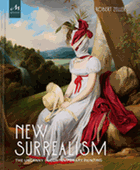
Robert Zeller (The Figurative Artist's Handbook) presents a fascinating exploration of the surrealist art movement on the occasion of the 100th anniversary of its origins. The beautifully illustrated New Surrealism: The Uncanny in Contemporary Painting is divided into three parts, the first of which provides a detailed description of the roots of surrealism, with all its factions and competing political allegiances, considered founded and led by writer and poet André Breton until his death in 1966.
The second part of the book explores the work of contemporary artists who share DNA, to one extent or another, with the surrealist movement. "It is not a formal movement," Zeller writes, "but rather an amorphous conglomeration of still-relevant themes of historical Surrealism mixed with many new influences."
The author attributes the staying power of surrealism less to a common dogma than to its evolution, writing: "More likely is that as Surrealism spread globally, the movement evolved to the next phase of its development. Its adaptability to different cultural norms and artistic disciplines is one of the main reasons why Surrealism still has currency as an influence in the contemporary art world. Artists in other countries who were influenced by Surrealism took what they found relevant and discarded the rest."
The final third of the book brings readers, intriguingly, into the studio practices of painters working today, along with surveys that elucidate the role that they feel surrealism plays in their production. It's a novel and incredibly rich way of showing the development of artistic expression across time and place. --Elizabeth DeNoma, executive director, DeNoma Literary Services, Seattle, Wash.

